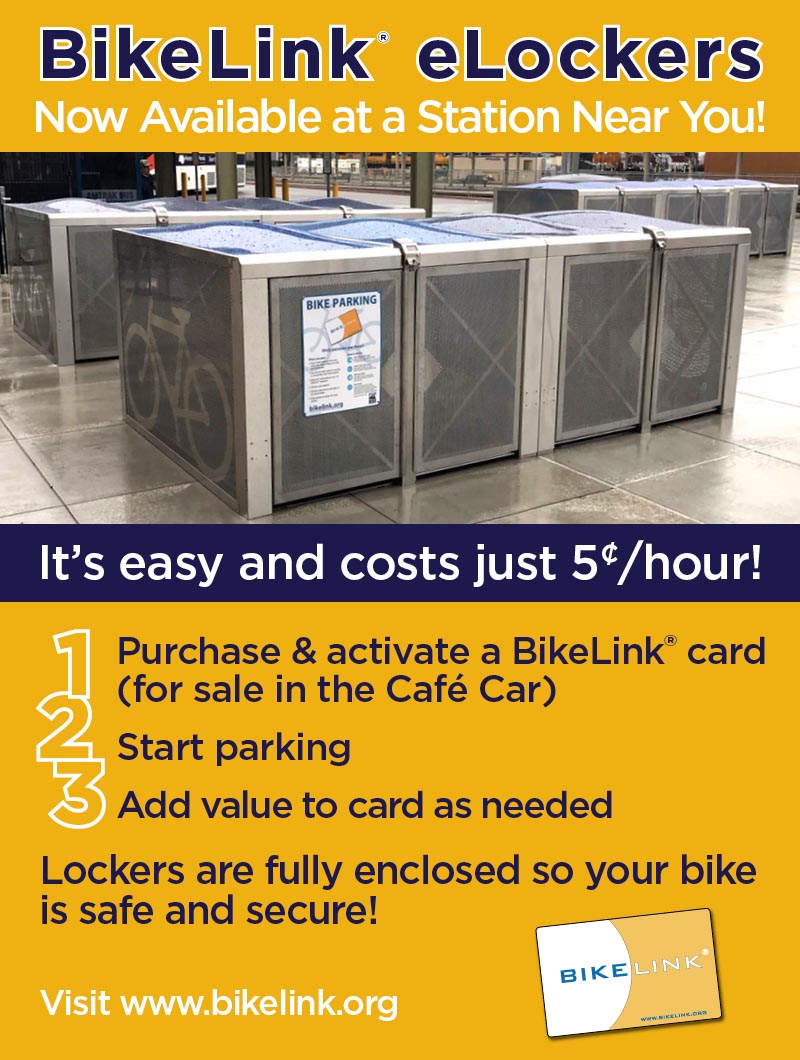A Bike Rider's Guide to Capitol Corridor
Bicycles and Trains – The Perfect Match
More and more people are discovering how well bicycle and train travel go together, whether it’s for commuting to work, enjoying a weekend ride, or participating in a bicycle tour. Learn more about how to use your bike with Capitol Corridor.
Bike Parking at Stations
For passengers who do not need to bring their bikes on the train, most stations have free racks for locking bicycles. There are also enclosed BikeLink eLockers costing 5 cents an hour at the following Capitol Corridor stations: Auburn, Roseville, Sacramento, Davis, Fairfield-Vacaville, Suisun-Fairfield, Martinez, Richmond (shared with BART), Berkeley, Emeryville, Oakland Jack London, Oakland/Coliseum (shared with BART), Hayward, Fremont, and Santa Clara/Great America.
Passengers using a BikeLink eLocker can pay using these three options: BikeLink Card, BikeLink App, and Transit Card (such as a Clipper card). BikeLink cards are also available at some staffed stations (Sacramento, Davis, Martinez, and Emeryville), and at select retail locations.
For information about getting, activating, and adding value to a BikeLink card, visit the BikeLink website.
On Board Bicycle Storage
Each Capitol Corridor train has two "bike cars," each with large-capacity storage to hold about a dozen bicycles, as well as luggage and other large items. The "bike cars" are designated by a decal -- generally the car furthest away from the locomotive and the second car away from the locomotive. In addition, each train car has three bike racks on the lower level.
What's allowed on board the train?
Standard bicycles, electric bikes, folding scooters up to 50 lbs., and non-folding scooters (must have a max tire width: 2.5") are allowed on Capitol Corridor trains. They can only be stored in designated bike cars and must be secured parallel or adjacent to the bike racks. They cannot block any aisles or walkways, impede passenger movement or present a safety hazard. If a non-folding scooter cannot meet these conditions it will need to be checked in a baggage car.
Folding bicycles under the dimensions of 34" x 15" x 48" (860 x 380 x 1120 mm) will be allowed on board in lieu of a piece of baggage.
If the bike racks are full, and you’re not sure where to store your bike, follow the instructions of the train crew on where to secure your bicycle so it won't block aisles and walkways.
For more information, read Amtrak's Onboard Bicycle Policy.
Bikes on Connecting Buses
Most connecting buses can accommodate a limited number of bicycles on a first-come, first-served basis. Storage on most buses is underneath the motor coach in the luggage compartment, and some buses (in particular, those providing service between Emeryville and San Francisco) also have front-end bike racks. As on the train, passengers are responsible for loading and unloading their bike.
Tips and Guidelines
- Look for and board the car with a visible bike decal. Most Capitol Corridor trains have two designated "bike cars" - generally the car furthest from the locomotive and the second car away from the locomotive.
- If you are storing your bicycle in one of the large capacity storage areas, use the hanging Velcro strap or your own bungee cord to secure your bike as tightly as possible to the train’s stabilizing bar. For extra security, you may also want to lock your bicycle to the stabilizing bar.
- If you are on one of the intermediate train cars, lock your bike securely to one of the designated bike racks. There are three in each of these cars, on the lower level.
- If you are not able to secure your bike either to a rack or in a storage area, find a location that does not block an aisle or walkway through which people (including people who use wheelchairs, canes, or walkers) could be moving.
- Regardless of where your bike is stored, make sure it is securely attached to the train car so it does not become a dangerous, moving object in the event of a sudden stop. Bungee cords are very helpful for this type of security, and are sold at minimal cost in the Café Car if you do not have one handy.
- If you need to fit your bike into a tight spot, clear of the aisle, try removing your quick-release front wheel.
- If possible, use a folding bicycle. With a folding bike, you still have your bicycle onboard without worrying about storage in the limited rack space.
Securing Your Bike in the Storage Area, Step-By-Step
Angled Bike Racks
- First lower the stabilization bar located to the left of the rack space you are going to use.
- Standing behind the bike, pull the handlebars up to stand the bike vertically.
- Guide the front tire into the angled metal rack and make sure it is secured. In some cases you may have to slightly lift the bicycle for it to rest in the proper position.
- Extend the stabilization bar to hook over the frame. You can lock your bike to the stabilization arm for extra security.
Vertical Bike Racks
- Standing behind the bike, pull the handlebars up to stand the bike vertically.
- Guide the front wheel onto the hook on the wall. You may have to lift the bike up a few inches.
- For a more secure fastening, lower the stabilization bar next to the front wheel and wrap the Velcro strap around the forks. You can also lock your bicycle through the stabilization bar. If there is no Velcro strap on the stabilizing bar, a bungee cord attached to the hook will also work.
- If bicycle hooks are blocked by baggage, leave the bike adjacent to the baggage, not blocking an aisle, and ask for the conductor's assistance.



